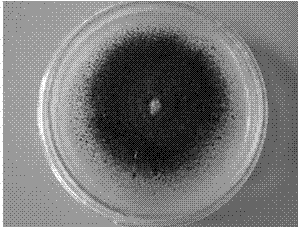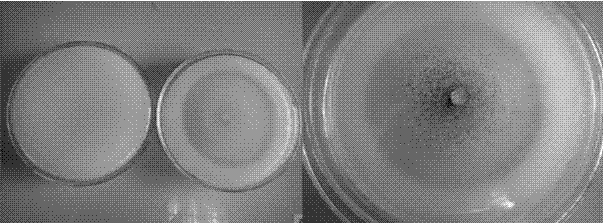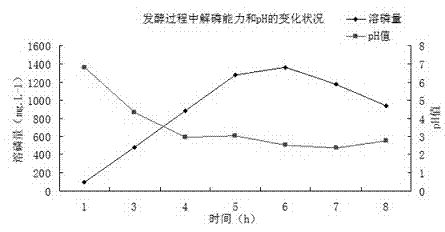Masson pine rhizosphere solubilizing phosphorus fungus aspergillus awamori and application thereof
A technology of Aspergillus awamori and phosphorus-solubilizing fungus, applied in the field of microorganisms, can solve the problems of less research on phosphorus-solubilizing fungi, and achieve the effects of excellent strain resources, growth promotion, and good application and development prospects
- Summary
- Abstract
- Description
- Claims
- Application Information
AI Technical Summary
Problems solved by technology
Method used
Image
Examples
Embodiment 1
[0021] The rhizosphere phosphorus-solubilizing fungus Aspergillus awamori (Aspergillus awamori) JP-NJ1 was screened from the rhizosphere soil of 30-40-year-old Pinus massoniana in Nanjing Forestry University. Such as figure 1 As shown, the colony grows rapidly on the PDA medium, and the diameter of the colony is about 65mm after 7 days of cultivation at 25°C. The colony is black, has radial grooves, and has a velvety texture; the reverse side of the colony is slightly light yellow. The conidiophores are mostly radial when they are young, with a diameter of 70-150um, and loose when they are old, with a diameter of about 300-500um; conidia are produced in large numbers, and they are densest in the middle of the colony and appear dark brown. Conidiophores occur in the stroma, about 600-800um×10um, pale brown when old, and fertile on the entire surface; the spore-producing structure is double-layered, the conidia are spherical or nearly spherical, 3.5-5um in diameter, and the wall...
Embodiment 2
[0024] Inoculate Aspergillus awamori JP-NJ1 on the NBRIP plate, culture at 25°C, observe whether there is still a lysing zone after 7-10 days, measure the diameter of the colony (D) and lysing zone (d), and calculate the diameter of the lysing zone and the diameter of the colony The ratio (d / D) of the phosphate-solubilizing fungi can be preliminarily estimated. Generally, the larger the ratio, the stronger the phosphorus-solubilizing ability of the fungus. According to Table 1, those whose phosphorus dissolving ability is "++" are considered to have stronger phosphorus dissolving ability. The d / D value of Aspergillus awamori JP-NJ1 was measured according to the above method, and the measured ratio was 1.44, indicating that the JP-NJ1 strain has a strong phosphorus-solubilizing ability.
[0025] Table 1 Grading standard of phosphorus-solubilizing ability of phosphorus-solubilizing fungi
[0026] d / D
Embodiment 3
[0028] Inoculate the Aspergillus awamori JP-NJ1 strain on the PDA plate, cultivate it for 10 days, and after activation, take the bacterial block (60mm in diameter) from the plate and inoculate it into a 100mL Erlenmeyer flask containing 50mL NBRIP liquid medium. NBRIP medium is the control (CK), each bottle is inoculated with 6 bacterial blocks of the same volume, and each strain to be tested is set up in triplicate, 25°C, 200r min -1 Shaking culture, after 7 days, centrifuge the fermentation broth for 10min (4°C, 10000r min -1 ), using the molybdenum-antimony anti-colorimetric method, that is, take 100uL of the supernatant obtained by the above centrifugation and add it to a 50mL volumetric flask, then add about 25mL of deionized water, and then add 1~2 drops of 2,4-dinitro Phenol indicator, add 5mL molybdenum antimony anti-color agent, add deionized water to make up to volume, mix well, after standing for 0.5h, measure the OD value. And calculate the available phosphorus c...
PUM
| Property | Measurement | Unit |
|---|---|---|
| diameter | aaaaa | aaaaa |
Abstract
Description
Claims
Application Information
 Login to View More
Login to View More - R&D
- Intellectual Property
- Life Sciences
- Materials
- Tech Scout
- Unparalleled Data Quality
- Higher Quality Content
- 60% Fewer Hallucinations
Browse by: Latest US Patents, China's latest patents, Technical Efficacy Thesaurus, Application Domain, Technology Topic, Popular Technical Reports.
© 2025 PatSnap. All rights reserved.Legal|Privacy policy|Modern Slavery Act Transparency Statement|Sitemap|About US| Contact US: help@patsnap.com



